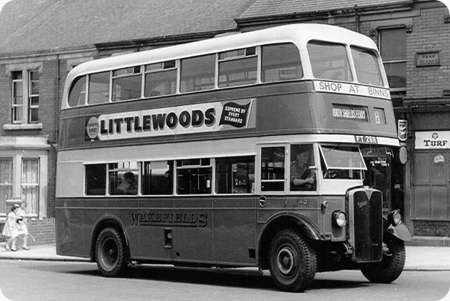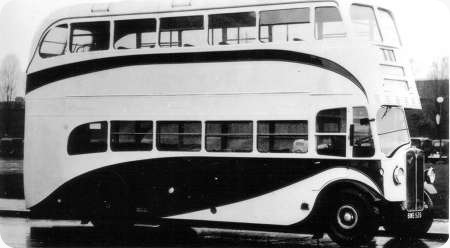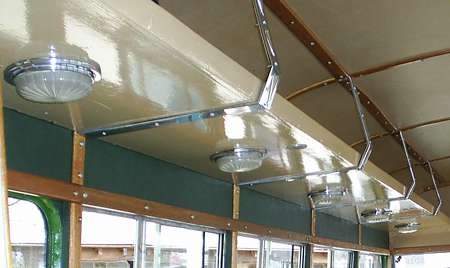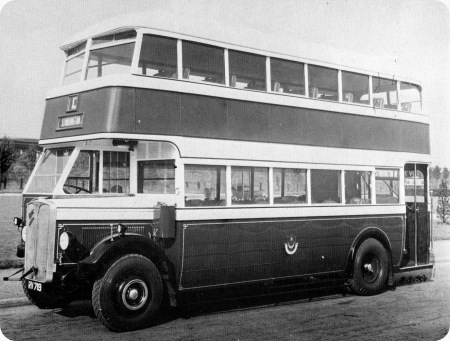
Photograph by ‘unknown’ if you took this photo please go to the copyright page.
Portsmouth Corporation
1931
AEC Regent I
Short Bros. H26/24R
This vehicle was one of two early diesel-engined buses bought by Portsmouth Corporation in 1931, the other being a Crossley Condor. They were both bought as an experiment and compared with four Leyland Titan TD1, bizarrely, petrol-engined versions, because Leyland didn’t offer a diesel engine then!
This ‘snouty’ AEC Regent, the Condor and two of the four TD1’s, were bodied by Short Bros. The body exudes a light, airy feel about the inside. Note the grills above the front downstairs window and the destination blind in the rear-most downstairs side window. Sadly, this unique vehicle in the fleet was destroyed by enemy action in 1941. The corporation, shortly after purchasing it, standardised on diesel-engined Leyland Titans and no more AEC buses were ever purchased. There are some intriguing aspects to this photo – firstly, there are two plates affixed to the radiator. One may well say Regent, would the other one say ‘diesel’? Secondly, it has a starting handle (for a diesel?), and, thirdly, the upper structure still appears to be in undercoat, yet the lower deck is gloss painted and lined out!
Photograph and Copy contributed by Chris Hebbron
———
25/05/12 – 07:48
I’ve seen a few pictures of pre-war (and wartime) diesels with starting handles. I seem to remember Roly Wason, in his entertaining book "Busman’s View" mentions that in West Hartlepool they would put a rope on the handle so that relays of men could "flick over" a recalcitrant bus.
Stephen Ford
———
25/05/12 – 07:49
A lovely photo of the classical era when buses were evolving. I believe the second plate on the AEC “Regent" radiator is “Oil Engine”. This plate was fitted to many AEC “Regents" with diesel engines in the period up to about 1935. Bradford Corporation “Regents” 396 to 419 of 1935 with 8.8 litre diesel engines had their radiators fitted with a second plate with “Oil Engine” inscribed.
Richard Fieldhouse
———
25/05/12 – 15:06
This attractive bus raises many questions, probably unanswerable, but here goes….. Portsmouth buses traditionally had the lining-out on the upper deck panels also. Was this only on later models, or could this have been a "rushed" official photo? In warm weather, it must have been quite hot on both decks with such limited ventilation. Were they modified later? Never having ridden in one, was there extra leg room on the front upper-deck seats under the "piano front" or was it panelled off purely for the destination box? Finally, the upper deck seats seem very high in relation to the height of the roof. It almost has the proportions of a lowbridge bus. Were they high-back seats or was it just a very high upper deck floor?
Paul Haywood
———
25/05/12 – 15:07
…..and, of course, the legend "Leyland Diesel" adorned the bonnet side of PD2s and PD3s right up to the end – despite "Leyland Petrol" being a thing of deepest history!
David Oldfield
———
26/05/12 – 06:38
With regard to Portsmouth Corporation not buying any further AEC buses after the Regent 1 they did in fact buy a batch of Swifts in 1969 with Marshall B42D bodywork I believe they were numbered 175-188 but I am not certain of those numbers.
Some Regent Vs also had a badge on the bonnet side which said AEC Diesel.
Diesel Dave
———
26/05/12 – 06:39
Paul, although no more experienced in this era than you, two points. (1) In order to avoid patent problems with Leyland and their low-bridge design, AEC came up with the camel back – a hump all the way down the middle. (If this is one, the photo is washed out at the roof and wouldn’t show it.) (2) There was a period of full-drop windows. If this is one of those, it would not be self evident with the windows fully closed.
David Oldfield
———
26/05/12 – 06:40
Thx for confirming my ‘oil engine’ thoughts, Richard.
To answer your thoughts as best I can, Paul, all buses were lined out, top and bottom, and this never changed, although it was simplified post-war. I’m inclined to think this is a ‘rushed’ official photo, although CPPTD often had their ‘tween decks adverts painted on for a long-term contract and might have been prepared to receive the bus like this for such an advert.
The ventilation might have been better than appears, for many buses, of the time, had one-piece sliding windows which came down about two-thirds of the way, worked by a car-type handle. I didn’t recall this type of seat back being any higher than was normal for slightly newer buses, so low window bottoms or a high floor must have been responsible. There was no need for lowbridge buses within its territory.
Chris Hebbron
———
26/05/12 – 06:42
The nameplates on the radiator say "Regent" and below "Oil Engine". This Portsmouth bus must have been an early recipient of the then very new 8.85 litre version of the AEC oil engine with the Ricardo Comet indirect injection system. This motor, which became successful and well known as the "8.8", appeared from mid 1931 in replacement of the indifferently reliable Acro head A155 engine, which had a capacity of 8.097 litres. The retention of a starting handle was quite common on early oil engined Regents.
It is noteworthy that, at about the same time as it bought this solitary AEC, Portsmouth purchased an example of the Crossley Condor with the 9.12 litre direct injection engine, and this must have impressed the Corporation rather more than the Regent, since another 20 buses of this type were bought in 1932. The continued specification by Portsmouth of the Crossley direct injection engine was another interesting feature, as by then, the indirect injection VR6 version was much more widely favoured. In any event, contrary to the experience of operators elsewhere in the country, the Crossleys earned their keep, turning in an average fuel consumption of 9.5 mpg until they were withdrawn in 1947. Probably on the strength of this earlier experience, notwithstanding a subsequent very successful allegiance to the Leyland Titan, Portsmouth bought more Crossleys in 1948, but the DD42/5T type proved to be another creature entirely in the reliability stakes. I must acknowledge that the sources of my information above are the books "Blue Triangle" by Alan Townsin, and "Crossley" by Messrs Eyre, Heaps and Townsin.
Roger Cox
———
26/05/12 – 06:43
I should have mentioned in my first ‘blurb’ that the bus was blinded route ‘D’ and ‘Stubbington Avenue’.
Chris Hebbron
———
26/05/12 – 16:52
Thanks, David and Chris for your replies. Yes, Chris, if I tilt my screen I think I can just about make out a domed roof which would explain the upper-deck proportions. However, I’m still not convinced about it being highbridge. In 1931, Belfast Omnibus Co. bought a batch of Short Bros Regents which, to my untrained eye, look almost identical, but these were classed as lowbridge. There is a photo of one on page 9 of "The British Bus Scene in the 1930’s" by David Kaye. Could the confusion (on my part) be to do with them being "low height" as opposed to having a lowbridge sunken-gangway seating layout?
Paul Haywood
———
26/05/12 – 16:53
Thx, Roger, for that interesting info. I never realised that pre-war Crossley engines were direct injection and produced such good mpg figures. They should have updated it, rather than introduced the HOE one, which had such a poor reputation, after they stopped infringing Saurer’s patent. Incidentally, whilst most of them were withdrawn in 1948, the rest were withdrawn in ones and two’s, the last in 1951, at 20 years old. And CPPTD also bought some DD42/7’s after the 5’s above: what gluttons for punishment! Probably a distress purchase, such was post-war bus/coach demand.
Chris Hebbron
———
28/05/12 – 07:51
Many thanks Chris, for this superb posting!
This was a fascinating and speedy era in bus development, and Portsmouth Corporation was a standard bearer in that department. They had batches of TD2s TSMs, and Crossley Condors, all with the same composite EEC bodies, so, from the rear, they would all look alike, and even the first TD4s had a similar 5 bay metal framed version.
It was a truly fascinating fleet, to say nothing about the 6 wheeled Karriers of a mere year or two earlier.
I think this Short bodied Regent is one of the first of the style which replaced the camel roof type, and was very common, mainly on AEC and Leyland chassis, all over the country.
Obviously, PCT were not particularly impressed with the AEC "oil engine", or Regents in general, as future orders, post 1933, were Leyland dominated, and one wonders why the trolleybus fleet became AEC based. Perhaps something to do with a liking for EEC equipment offered by the AEC/EE partnership?
Just imagine what it would have been like to be an enthusiast in Pompey in the 1930s, with such a fascinating bus fleet, and so many experimental trolleybuses too! Its the stuff that dreams are made of!
John Whitaker
———
28/05/12 – 07:52
I feel this must be an official view, taken I suspect by the bodybuilder, but why the upper deck painting was not complete is beyond me. This bus and all the other Short bodies bought by Portsmouth were highbridge, photos of all the others had the seat backs visible through the windows, they must therefore have had a high floor. This same characteristic is shown on Short bodied TD1 and TD2’s with Southdown.
A summer photo of one of Portsmouth’s Short bodied TD1’s shows 3 upstairs windows each side open a good half way, so ventilation would have been fine.
Finally Service C/D didn’t run to Stubbington Avenue, so I suspect the screen were set randomly for the official photo.
Pat Jennings
———
29/05/12 – 06:49
Just to confirm Diesel Dave’s comment about post-war Portsmouth AEC’s. There were 12 saloons, all of them Swift 2MP2R chassis, and had Marshall B42D bodies. They were numbered 176-187 (NTP176-187H), entering service in Aug/Sep 1969. They followed two batches of Leyland Panther Cubs, 12 with Marshall bodies, and 14 with Metro-Cammell bodies (all B42D, new March to Oct 1967, Nos 150-175). I recall reading that the AEC Swift and Leyland Panther shared the same chassis frame design, as AEC was part of the Leyland group from 1962. But I don’t know what similarities there were between the smaller Panther Cub and the Swifts delivered to Portsmouth, apart from overall length – Portsmouth did not want maximum size 36-footers for it’s city routes. It’s generally acknowledged that the Panther Cub was not a great success, and Portsmouth began withdrawal in 1977 – a mere 10 years – the final ones going in 1981. The AEC Swifts went swiftly however (oops! – sorry!) – The MAP project in 1981 saw the fleet significantly reduced, and the remaining Panther Cubs plus the 12 Swifts, (and 14 Leyland Nationals, only 5 years old) were all withdrawn and sold.
On a different note, the Portsmouth Regent No 35 with it’s Short Bros body could be theoretically compared with it’s Southdown equivalent. But Southdown’s version (also with Short Bros highbridge body of similar design) was petrol engined, and hired, not owned. It was their No 10, and was lettered on the sides for a route in Horsham. Thus it is very unlikely that the two were ever side by side at South Parade Pier!
It is one of those fascinating details that Portsmouth had two AEC double-deckers pre-war, both were numbered 35, and both had comparatively short lives. Our featured Regent was destroyed in the air-raid of 10 March 1941, and only the engine was salvaged and sold to Nottingham Corporation. The previous 35 was an AEC "B"-type purchased in 1926 from LGOC via a dealer(new c.1913) with a Dodson body, along with ten other Dodson bodies, which were used on the original 10 Thornycroft Js. It didn’t last long, but in it’s short career it was re-registered from LF 9344 to BK 2342 (transferred from a service vehicle), and had it’s body replaced by one of the Wadham bodies from the original Thornycrofts, albeit cut down to a single-decker! It was withdrawn from PSV use in 1927, and was used as a petrol tender until 1930 – probably to keep the thirsty Karrier 6-wheelers going in service.
Michael Hampton
———
30/05/12 – 07:21
Thank you, Michael, for the additional information, especially that of the first 35 and its interesting life.
You mention the air raid of 10th March 1941 (with the loss of quite a few vehicles, including two Crossley Condors) but I’ve never seen mention of which depot it was. I assume from the loss of buses, not trolleybuses, that it was North End and not Eastney.
Chris Hebbron
———
30/05/12 – 13:30
Thanks Chris for your kind comments. All the books and notes I have state that it was Eastney depot which was badly damaged on 10th March 1941, destroying ten buses, and damaging others. Both trolleybuses and motorbuses were kept at North End and Eastney depots. My source says that the incendiary bombs hit the bus garage and workshops. There was also damage across the city, and several major trolleybus routes had to be curtailed until wiring and road repairs were completed. There was bomb damage at North End depot, too (date not given), but this was restricted to store rooms, no vehicles apparently involved. But no trolleybuses received major war damage at either Eastney, North End, or on the streets.
Michael Hampton
———
30/05/12 – 17:37
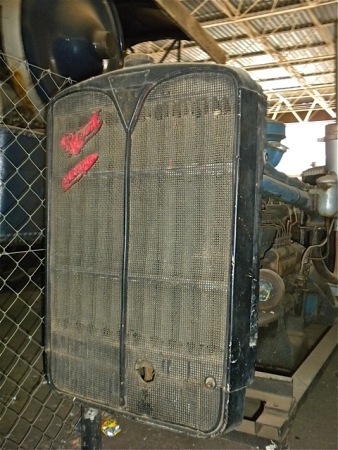
Last year I visited the Transport Museum in Johannesburg a took a photo of an AEC Regent radiator mounted on a sub-frame with a 8.8 litre engine circa 1935.
The stored exhibit had lost its the AEC triangle badge but does have "Regent" and "Oil Engine" plates on the radiator wire mesh as well as the spline for a starter handle. I would have posted this photo sooner but made the previous entry when on holiday. Chris, please keep posting these lovely pre-war photos of Portsmouth Corporation.
Richard Fieldhouse
———
31/05/12 – 10:50
Well, Richard, what an unusual find and way to prove a point! As for other ‘Pompey’ photos, I’ve a couple more up my sleeve. The quick and sad end of CPPTD, I try to keep at the back of my mind!
Chris Hebbron
